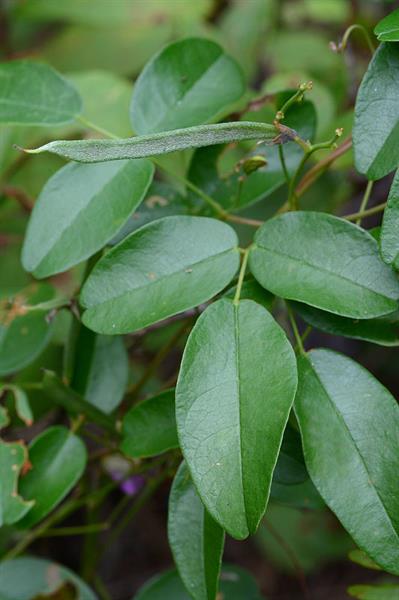
ID notes:Galactia regularis refers to the species widespread in the eastern USA, with leaflets mostly elliptic to broadly elliptic, relatively small flowers, and twining stems hirsute-villous with deflexed hairs (Nesom 2015).
Origin/Endemic status: Native
Synonymy: = Fl3, FNA11.1, GrPl, K4, NY, WH3, Duncan (1979), Franck (2017), Nesom (2015a), Ward & Hall (2004); = Galactia volubilis (L.) Britton – K1, S, SE3, Tn, Isely (1998), misapplied; > Galactia macreei M.A.Curtis – C, F, G, RAB, Tx; > Galactia regularis var. mississippiensis (Vail) Mohlenbr. – Il, invalid name; > Galactia regularis var. regularis – Il; < Galactia volubilis (L.) Britton – Ar, NcTx, Tat, WV, misapplied; > Galactia volubilis (L.) Britton – C, G, Pa, RAB, Tx; > Galactia volubilis (L.) Britton var. mississippiensis Vail – F; > Galactia volubilis (L.) Britton var. volubilis – F
Wetland Indicator Status:
- Atlantic and Gulf Coastal Plain: FACU (taxonomic split from wetland indicator species)
- Eastern Mountains and Piedmont: FACU (taxonomic split from wetland indicator species)
- Great Plains: FACU (taxonomic split from wetland indicator species)
- Midwest: FAC (taxonomic split from wetland indicator species)
- Northcentral & Northeast: FAC (taxonomic split from wetland indicator species)
Heliophily: 7
Hover over a shape, letter, icon, or arrow on the map for definition or see the legend.
 © Gary P. Fleming | Original Image ⭷
© Gary P. Fleming | Original Image ⭷ © Gary P. Fleming | Original Image ⭷
© Gary P. Fleming | Original Image ⭷ © Will Stuart | Original Image ⭷
© Will Stuart | Original Image ⭷ © Aidan Campos source | Original Image ⭷
© Aidan Campos source | Original Image ⭷ © Alan Weakley source | Original Image ⭷
© Alan Weakley source | Original Image ⭷ © Alan Weakley source | Original Image ⭷
© Alan Weakley source | Original Image ⭷Feedback
See something wrong or missing on about Galactia regularis? Let us know here: (Please include your name and email if at all complicated so we can clarify if needed.)
Cite as...